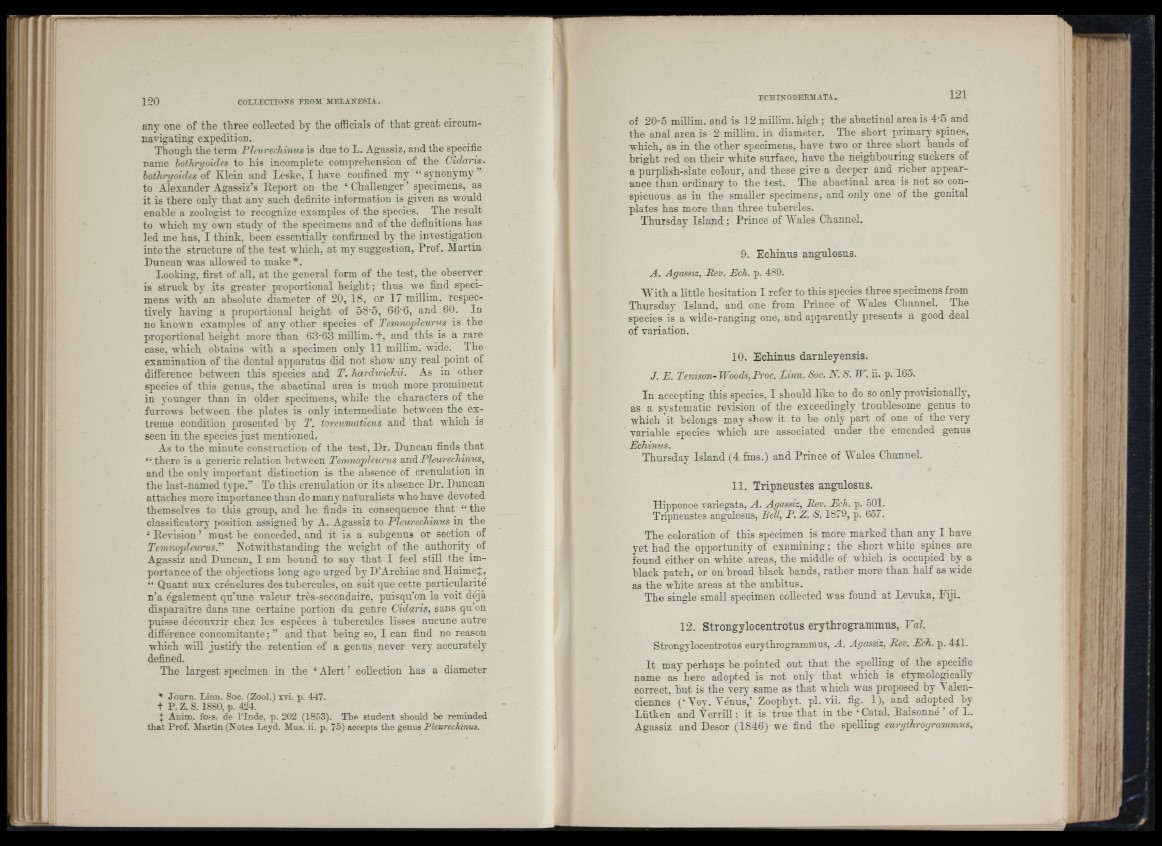
ï l \
120 COLLECTIONS FEOM MELANESIA.
any one of the three collected by the officials of th at great circumnavigating
expedition.
Though the term Phureclnnus is due to L. Agassiz, aiid the specific
name hothryoides to his incomplete comprehension of the Cidaris^
bothiyoides of Klein and Leske, I have confined my “ synonymy ”
to Alexander Agassiz’s Keport on the ‘ Challenger ’ specimens, as
it is there only th at any such definite information is given as would
enable a zoologist to recognize examples of the species. The result
to which my own study of the specimens and of the definitions has
led me has, I think, been essentially confirmed by the investigation
into the structure of the test which, at my suggestion. Prof. Martin
Duncan was allowed to make*.
Looking, first of all, at the general form of the test, the observer
is struck by its greater proportional height ; thus we find specimens
with an absolute diameter of 20, 18, or 17 millim. respectively
having a proportional height of 58-5, 66-6, and 60. In
no known examples of any other species of Temnopleurus is the
proportional height more than 63’63 millim. f , and this is a rare
case, which obtains with a specimen only 11 milhm. wide. The
examination of the dental apparatus did not show any real point of
difference between this species and T. hardwichii. As in other
species of this genus, the abactinal area is much more prominent
in younger than in older specimens, while the characters of the
furrows between the plates is only intermediate between the extreme
condition presented by T. toreumaticus and th at which is
seen in the species ju st mentioned.
As to the minute construction of the test. Dr. Duncan finds th at
“ there is a generic relation between Temnoqol eurus aaà Pleur echinus,
and the only important distinction is the absence of crenulation in
the last-named type.” To this crenulation or its absence Dr. Duncan
attaches more importance than do many naturalists who have devoted
themselves to this group, and he finds in consequence th at “ the
classificatory position assigned by A. Agassiz to Pleurechinus in the
‘ Eevision ’ must he conceded, and it is a suhgeuus or section of
Temnopleurus.” Notwithstanding the weight of the authority of
Agassiz and Duncan, I am hound to say th at I feel still the importance
of the objections long ago urged by D’Archiac and HaimeJ,
“ Quant aux crénelures des tubercules, on sait que cette particularité
n ’a également qu’une valeur très-secondaire, puisqu’on la voit déjà
disparaître dans une certaine portion du genre Cidaris, sans qu’on
puisse découvrir chez les espèces à tubercules lisses aucune autre
différence concomitante ; ” and th at being so, I can find no reason
which will justify the retention of a geuus never very accurately
defined.
The largest specimen in the ‘ Alert ’ collection has a diameter
* Journ. Linn. Soc. (Zool.) xvi. p. 447.
t P. Z. S. 1880, p. 424.
\ Anina. fofs. de I’lnde, p. 202 (1853). The student should be reminded
that Prof. Martin (Notes Leyd. Mus. ii. p. 75) accepts the genus Pleurechinus.
of 20-5 millim. and is 12 millim. high ; the ahactinal area is 4-5 and
the anal area is 2 millim. in diameter. The short primary spines,
which, as in the other specimens, have two or three short bands of
bright red on their white surface, have the neighbouring suckers of
a purplish-slate colour, and these give a deeper and richer appearance
than ordinary to the test. The abactinal area is not so conspicuous
as in the smaller specimens, and only one of the genital
plates has more than three tubercles.
Thursday Island : Prince of AYales Channel.
9. Echinus angnlosus.
A. Agassiz, Rev. Ech. p. 489.
AAAth a little hesitation I refer to this species three specimens from
Thursday Island, and one from Prince of AA ales Channel. The
species is a wide-ranging one, and apparently presents a good deal
of variation.
10. Echinus darnleyensis.
J. E. Tenison-Woods,Proc. Linn. Soc. A . S. W. ii. p. 165.
In accepting this species, I should like to do so only provisionally,
as a systematic revision of the exceedingly troublesome genus to
which 'i t belongs may show it to be only part of one of the very
variable species which are associated under the emended genus
Echinus.
Thursday Island (4 fms.) and Prince of AYales Channel.
11. Tripneustes angnlosus.
Hipponoe variegata, A. Agassiz, Rev. Ech. p. 501.
Tripneustes angulosus, Bell, P. Z. S. 1879, p. 657.
The coloration of this specimen is more marked than any I have
yet had the opportunity of examining ; the short white spines are
found either on white areas, the middle of which is occupied by a
black patch, or on broad black hands, rather more than half as wide
as the white areas at the ambitus.
The single small specimen collected was found at Levuka, Fiji.
12. Strongylocentrotus erythrogrammus, Val.
Strongylocentrotus eurythrogrammus, A. Agassiz, Rev. Ech. p. 441.
I t may perhaps be pointed out th at the spelling of the specific
name as here adopted is not only th at which is etymologically
correct, but is the verj' same as th at which was proposed by A alen-
ciennes ( ‘Yov. Yénus,’ Zoophyt. pi. vii. fig. 1), and adopted by
Lütken and te rriU ; it is true that in the ‘ Catal. Eaisonné ’ of L.
Agassiz and Desor (1846) we find the speUiug eurythrogrammus.
( »!|
i (I ':